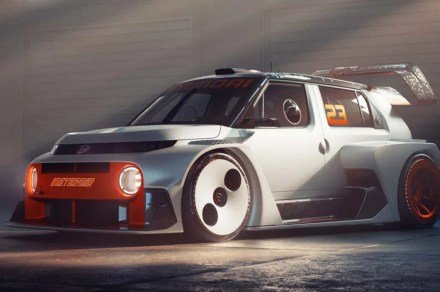BMI Calculator – Check your Body Mass Index for free!
Hyundai Insteroid is a one-off we really want, but may not get
Hyundai / Hyundai
The Hyundai Insteroid is an eye-melting example of what can be generated when designers are allowed to have some fun.
This takes the Hyundai Inster EV, and turns that city-hopping micro-motor into a fully tuned performance machine that looks as fast as it does confident and charismatic.
The name alone is fun to play with: this is worthy of Insta photos but it’s also clearly all pumped up on ‘roids.
As you can see from the lead image, this has aggressive flared arches, a sharp front splitter and utterly massive air intakes on the side skirts.
Head around the back and you’ve got a spoiler that wouldn’t look out of place on a car double the Insteroid’s size. You’ve also got a new rear diffuser to add to the aggressive look on this street racer.
Even the wheels have had some serious attention to detail with variations to the front and rear. The front sporting those three circle spokes and the rear rocking some deep dishes in that punhcy red/orange finish.
Inside the fun continues with bucket seats and a roll cage, as well as a super specialized and minimal instrument cluster behind that race-spec steering wheel, complete with analogue buttons and switches.
Then there’s that audio setup in the boot space that’s impossible not to notice. It looks like a DJ has setup shop ready to play a gig right out of the back of this car. And perhaps that’s the idea. The audio kit, from Beat House, looks speaker heavy and color coded to match the car perfectly.
This is very much a concept at this stage, created by Hyundai to inspire the next generation of designers to push the boundaries of what’s possible. And perhaps to keep up with the – actually built – street racing beast that was recently revealed as the Renault 5 Turbo 3E.
Luke has over two decades of experience covering tech, science and health. Among many others, Luke writes about health tech…
Windows 11 may get the 3D emojis we were promised
Microsoft shipped new emojis in Windows 11 last year, but they caused quite some controversy as the emojis weren’t actually 3D as the company first teased. There was never an explanation for that change in design, but it is now looking as though the originally promised 3D emoji could still be in the works.
Though Microsoft itself hasn’t recently said anything about 3D emoji on its official channels, one of its employees sent indications about it. In a response to a tweet from a Windows 11 user lamenting the lack of 3D emoji, Nando Costa, who is the visual artist and design leader at Microsoft Design, said: “Thank you and agreed! We’re working on that.”
Rivian is more tech company than car company, and that’s a good thing
The car world is kind of split right now. There are the legacy automakers — the ones you know and love — but there are also the new startups building all-new kinds of cars. The first of that new generation of car companies was Tesla, and obviously by now it’s certainly not a startup. But over the past decade or so others have popped up. There’s Lucid, which builds ultra-premium EVs, and, of course, there’s Rivian, which has secured its spot as the go-to for those who want a more rugged EV.
I was recently able to tour Rivian’s Palo Alto location and one thing became clear. The divide between traditional carmakers and the new startups is much deeper than just when they were founded. Companies like Rivian, in fact, are actually tech companies, that built high-quality computers that happen to have wheels on them.
Watch this BBC report from 1971 about the ‘car radio of the future’
The next time you power up your snazzy in-car entertainment system, consider for a moment this BBC presenter who in 1971 was sent to report on a car-based contraption that back then was at the forefront of innovation.
The BBC recently shared the wonderfully nostalgic segment from Tomorrow’s World, a popular tech show that ran in the U.K. for nearly four decades until 2003.
BMI Calculator – Check your Body Mass Index for free!

